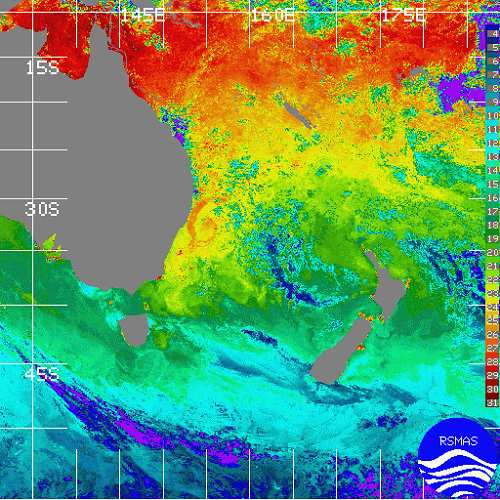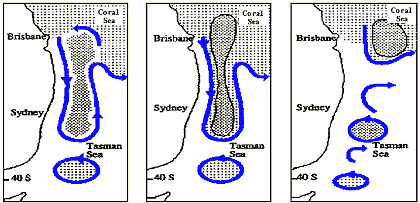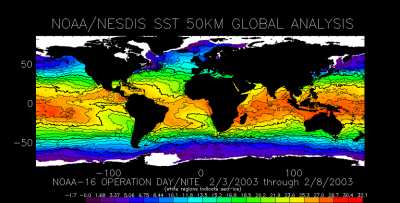Theme
Exploring Our Oceans - Oceanography from Space
Obtain a Sea Surface Temperature image of the Eastern Australian Current from
www.rsmas.miami.edu/images.html and follow the links under Western boundary currents.
Here is a sample image from this site (6/2/03).

Activity 1 - A Different View of the Ocean
Carefully look at the images of sea surface temperature for the oceans around eastern Australia
Make a list of differences between the northern and southern Australia in sea surface temperatures.
Using the information in the side colour bar to determine which colours represent waters that are warm or cool. The scale shows temperature differences in colour.
Once you have determined how the image depicts colder water, locate the coldest part of the ocean. In general, where is the warmest water in the image? Why is it warmer? Look for areas of cold water along the coast that are caused by upwelling.
Find other examples of warm water and cold water currents from some of the other images on the RSMAS page.
Explain how changes in these currents might effect the sorts of animals that might live in different parts of the Australian Coastline. Divers have often noticed that on the central eastern seaboard, in New South Wales, or in New Zealand, they can often see corals and other marine life found on the Great Barrier Reef mixed with cold water animals. Can you explain why?
Activity 2 - Where's Eddy Now?
Sometimes the East Australian Current makes large loops that extend out into the Pacific Ocean and even reach New Zealand. This forms an eddy of water that may move at speeds of 2-3 knots and may occasionally persist for 3-5 years. Eddies can be up to 200 miles in diameter. Eddies or "rings" are features that are easily seen from space by infrared sensors.
The East Australian Current separates warmer water from the Coral Sea and cooler water from Bass Strait and the Southern Ocean. Occasionally some of the warm water is trapped by cooler water around it and may last for several months. Cool water can also be trapped in a ring of warm water. Warm rings can contain different types of animals than normally survive in cooler water. Sea turtles, for example, have been found in eddies many thousands of kilometres from their normal range.
- Find some examples of warm water eddies in the East Australian Current from the sea surface temperature images. Use the temperature scale to determine the relative temperature difference between the center of the ring and of the surrounding water.
- Alternatively find some eddies in SST images of the Gulf Stream on the East Coast of the USA, or other boundary currents also found at http://www.rsmas.miami.edu/images.html
- Discuss how they move nutrients and phytoplankton, and occasionally, large animals like fish, sea turtles, and Portuguese Man-O-War jellyfish into different parts of the southern Pacific

Activity 3 - Cool Water Wonders
Obtain a global Sea Surface Temperature with a 50 or 100km resolution in colour image from the selection at
http://www.osdpd.noaa.gov/PSB/EPS/SST/contour.html Go to the GLOBAL links Colour towards the bottom of the page.
Here is a sample:

Click for larger image
Determine the temperature of the sea surface at the following locations - San Diego, California.? South Korea? Southern Australia? South Africa? All of these locations share a similar water temperature and as a consequence have similar habitats although differ markedly in species composition. If kelp forests are known to be found in California and in Southern Australia predict other places where they may be found.
With modern shipping many marine species of animals and plants can be easily transported to other parts of the globe. They may, if conditions are suitable, become pest species - a good example is the Northern Pacific Seastar which is now rapidly spreading through southern Australia after arriving in ballast water from Japan / Korea. What other places is this animal likely to become a pest if introduced? To protect from invasion by alien species, authorities in Victoria should closely monitor which country's ships?
|